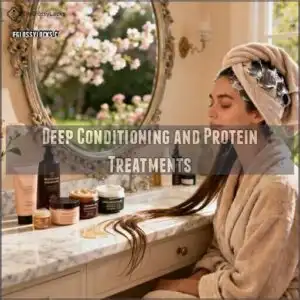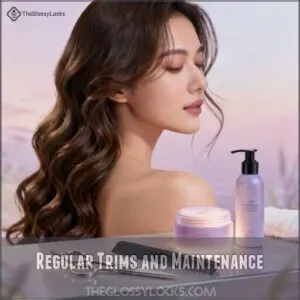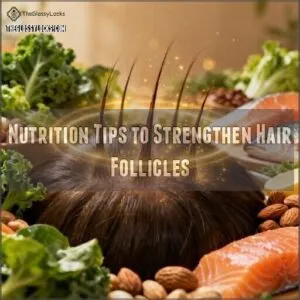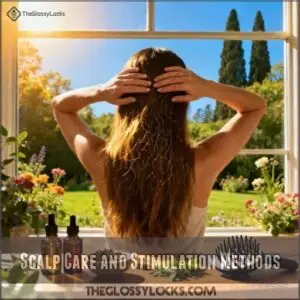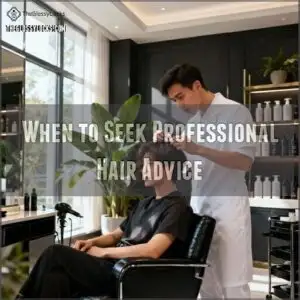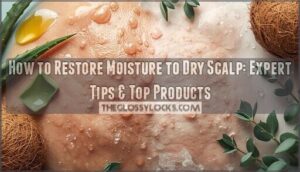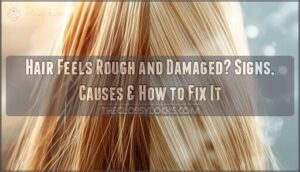This site is supported by our readers. We may earn a commission, at no cost to you, if you purchase through links.
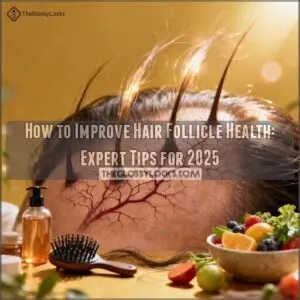
Poor nutrition starves the roots. Chemical treatments burn through protective layers. Stress rewires growth cycles at the cellular level.
The good news? You can reverse much of this damage. Strengthening your follicles requires understanding what harms them first. From hormonal shifts to scalp care missteps, each cause has a solution. Small adjustments to your routine can rebuild resilience where it matters most—at the root.
Table Of Contents
- Key Takeaways
- What Causes Hair Follicle Damage?
- Essential Haircare Habits for Follicle Health
- Nutrition Tips to Strengthen Hair Follicles
- Scalp Care and Stimulation Methods
- When to Seek Professional Hair Advice
- Frequently Asked Questions (FAQs)
- How to make your hair follicles more healthy?
- Can you regenerate hair follicles naturally?
- What are the big 3 for hair regrowth?
- How can I repair my hair follicles?
- Can hair supplements replace a balanced diet?
- How often should you change your pillowcase?
- Whats the best water temperature for washing?
- Can over-brushing damage your hair follicles?
- Conclusion
Key Takeaways
- Hair follicle damage stems from controllable daily factors—hormonal imbalances (especially elevated DHT), nutritional deficiencies (particularly protein, iron, zinc, and vitamin D), environmental stressors (UV exposure, pollution, harsh water), and excessive heat styling or chemical treatments that directly weaken follicle structure.
- Consistent scalp care strengthens follicles from the outside: wash 2-3 times weekly with sulfate-free products, massage your scalp daily for four minutes to boost blood flow, exfoliate monthly to remove buildup, and protect hair with silk pillowcases and UV-blocking products to prevent ongoing damage.
- A nutrient-dense diet directly fuels follicle health—prioritize protein-rich foods (eggs, salmon, lentils), omega-3 fatty acids (fatty fish, walnuts, flaxseeds), and adequate hydration (eight glasses daily) to support keratin synthesis and maintain the growth cycle at the cellular level.
- Professional intervention becomes necessary when you notice sudden shedding beyond 50-100 strands daily, patchy baldness, or progressive thinning at the roots—dermatologists can offer targeted treatments like minoxidil, finasteride, PRP therapy, or laser treatments that home care can’t provide.
What Causes Hair Follicle Damage?
Your hair follicles face daily threats that can weaken their structure and disrupt healthy growth. Understanding what damages them is the first step toward protecting your hair from the inside out.
Here are the main culprits that compromise follicle health.
Hormonal Imbalance
When hormones go off balance, your hair follicles feel it first. Androgen effects—especially elevated DHT levels—shrink follicles and shorten hair growth cycles, affecting roughly 50% of adults with androgenetic alopecia. Declining estrogen levels after menopause trigger hair loss, while thyroid health issues cause diffuse shedding in up to half of hyperthyroid patients. Cortisol impact from chronic stress pushes follicles into early rest phases.
PCOS hirsutism complicates scalp health further through hormonal imbalance affecting hair growth patterns. Stress can also lead to hair loss, as high cortisol levels damage hair follicles.
Poor Nutrition
What you eat directly shapes follicle health. Dietary Deficiencies wreak havoc—over 90% of hair loss patients show histidine or alanine shortfalls, while leucine deficiency hits 98% of telogen effluvium cases. Protein Malnutrition starves follicles of the building blocks they need.
Vitamin Imbalance matters too: up to 89% of women with hair loss lack sufficient vitamin D. Mineral Depletion of iron, zinc, and copper weakens strands. Addressing hair loss often involves checking ferritin and B12 levels.
Without a nutrient-dense diet supporting hair nutrition, your hair growth stalls before it starts.
Environmental Stressors
Your scalp faces constant attack from outside forces. Air pollution clogs follicles with particulate matter, triggering oxidative stress. UV radiation breaks down protein structures, causing hair damage. Water quality issues—chlorine, hard minerals—strip natural oils. Climate impact from extreme heat or cold disrupts the growth cycle.
Four environmental factors that compromise hair follicles:
- Smog and urban pollutants coat your scalp daily
- Sun exposure degrades keratin and weakens strands
- Chlorinated or mineral-heavy water causes brittleness
- Temperature extremes shock follicles into shedding
Protective measures—hats, UV sprays, filtered shower heads—shield against these threats to hair growth.
Excessive Styling and Chemicals
Heat tools and harsh chemicals inflict direct trauma on follicles—damage you control but often overlook. Flat irons exceeding 400°F cause heat damage by denaturing keratin. Chemical overload from relaxers, bleach, and permanent dyes weakens the follicle structure. Product buildup clogs openings, suffocating growth. Tight weaving and daily heat styling accelerate hair breakage.
Protective measures matter: heat protectants, styling alternatives like air-drying, and monthly clarifying washes prevent hair follicle damage from excessive styling and product use.
Chronic Stress
Stress doesn’t just live in your mind—it rewires your follicles at the cellular level, pushing them prematurely into a resting phase that halts growth. Elevated cortisol disrupts the growth cycle, triggering stress and shedding within months. Chronic stress starves follicles of nutrients, weakening hair from the root.
Stress rewires your follicles at the cellular level, triggering premature shedding and starving roots of essential nutrients
Stress management through scalp massage, meditation, and lifestyle changes protects mental health and preserves hair growth by rebalancing your body’s stress response.
Essential Haircare Habits for Follicle Health
Your daily haircare routine either strengthens your follicles or wears them down over time. Small adjustments to how you wash, condition, and maintain your hair can make a measurable difference in follicle health.
Let’s look at the habits that protect your hair from root to tip.
Washing Frequency and Techniques
Washing your hair too often strips away the natural oils that keep your follicles strong, but skipping washes entirely can clog those same follicles with buildup—so finding the right balance is everything.
Aim for two to three washes per week using a sulfate-free shampoo. Apply a quarter-sized amount to your scalp—not your lengths—and massage gently for scalp stimulation.
Rinse with lukewarm water temperature to avoid irritation. Pat dry with a microfiber towel for gentle drying that protects hair follicles from friction damage.
Choosing The Right Products
Your shampoo bottle might promise miracles, but the real turning point is matching your product lineup to what your follicles actually need. Look for sulfate-free shampoo with nourishing product ingredients like biotin or keratin that match your hair type.
Test new hair care products on a small section first. Your hair and scalp will thank you when you choose formulas designed for follicle health, not just marketing hype.
Deep Conditioning and Protein Treatments
Think of deep conditioning like physical therapy for damaged strands—it rebuilds what heat and styling have broken down.
Apply deep conditioning masks weekly to restore moisture, then alternate with protein treatments every two weeks to strengthen hair follicles and prevent hair breakage. Focus application techniques on mid-lengths to ends, leaving product on for 20 minutes.
Select treatments based on ingredient benefits—look for keratin, collagen, or DIY recipes using egg yolk for targeted hair treatment results.
Regular Trims and Maintenance
Skipping regular trims is like ignoring a crack in your windshield—small splits travel upward and force you to cut off more length later. Schedule trims every 8-12 weeks to prevent split ends from compromising hair strands and slowing your hair growth cycle.
- Trim frequency depends on your styling habits—heat users need cuts every 6-8 weeks
- Apply leave-in maintenance products after trims to seal ends and reduce hair breakage
- Avoid aggressive styling after trims; let hair strands recover for 48 hours
- Monitor for hair thinning patterns between appointments to catch follicle issues early
Nutrition Tips to Strengthen Hair Follicles
Your hair follicles need the right fuel to thrive, and that starts with what’s on your plate. The foods you eat directly impact follicle strength, growth cycles, and overall scalp health.
Let’s break down the essential nutrients your hair needs and where to find them.
Key Vitamins and Minerals
Certain vitamins and minerals act like building blocks for strong hair follicles. Vitamin D aids keratinocyte function and follicle cycling, while iron deficiency disrupts oxygen delivery to follicles. Zinc benefits include enzymatic regulation of growth cycles. Biotin supplementation corrects deficiencies causing brittle hair.
Antioxidant vitamins protect follicles from damage, though balance matters—excess vitamin A can trigger shedding.
A nutrient-dense diet provides what your follicles need most.
Protein-Rich Foods
Hair is primarily made of keratin protein, so getting enough protein-rich foods directly aids follicle function and strand strength. Amino acids from dietary sources fuel keratin synthesis, the process that builds each strand. Your body can’t store excess protein, so consistent intake matters.
Include these protein-rich foods for best follicle health:
- Eggs – Complete protein with biotin for keratin synthesis and follicle strength
- Salmon and fatty fish – High-quality protein plus nutrients that aid protein absorption
- Lentils and chickpeas – Excellent vegan proteins with iron for follicle cycling
- Greek yogurt – Packed with protein to nourish hair follicles throughout the day
- Lean chicken and turkey – Nutrient-dense diet staples providing essential amino acids
Omega-3 Fatty Acids
Your body can’t produce omega-3 fatty acids on its own, so you need to get them from food to keep follicle membranes healthy and reduce scalp inflammation that weakens hair growth. These essential fats support follicle nourishment and scalp hydration while promoting a nutrient-dense diet that strengthens hair health.
| Omega-3 Sources | Key Benefits | Dietary Integration |
|---|---|---|
| Salmon, mackerel, sardines | Inflammation reduction at follicle level | Two to three servings weekly |
| Walnuts and flaxseeds | Plant-based follicle support | Daily handful or tablespoon ground |
| Chia seeds and hemp hearts | Scalp hydration and omega-3 delivery | Sprinkle on meals or blend into smoothies |
Hydration and Healthy Fats
Drinking enough water throughout the day—at least eight glasses—keeps your scalp hydrated and helps transport nutrients directly to your follicles. Healthy fats from foods like avocados and olive oil lock in moisture and support the absorption of fat-soluble vitamins that strengthen hair.
These dietary fats work alongside omega-3 fatty acids to maintain scalp health and hair hydration. Include hydrating foods like cucumbers and watermelon in your nutrient-rich diet to boost water intake while supporting hair follicles from the inside out.
Scalp Care and Stimulation Methods
Your scalp is the foundation where healthy hair begins, and caring for it properly makes all the difference. Simple daily practices can boost blood flow to your follicles, remove buildup, and create the ideal environment for growth.
Here’s what you can do to keep your scalp in top condition.
Daily Scalp Massage Techniques
A simple scalp massage isn’t just relaxing—it’s one of the most effective ways to wake up sluggish hair follicles and boost circulation. Aim for four minutes daily using gentle, circular motions with your fingertips. Apply light to moderate pressure on key pressure points around your hairline and crown.
You can use your hands alone or try a silicone massage tool for consistent scalp stimulation. Adding oils like rosemary or peppermint improves blood flow even more.
Exfoliating and Cleansing The Scalp
Think of your scalp like any other part of your skin—it sheds dead cells, collects oil, and needs regular exfoliation to stay healthy and balanced. Gentle exfoliation once or twice monthly removes product buildup and improves scalp circulation without irritating your follicles.
Choose from these scalp scrub types:
- Physical scrubs with sugar or salt crystals
- Chemical exfoliants containing salicylic acid
- Clay-based cleansers for oil control
- DIY scalp cleansers using brown sugar and coconut oil
Keep your scalp care routine simple and consistent for the best scalp condition.
Using Oils and Natural Remedies
Natural oils and targeted remedies offer a straightforward way to nourish your follicles from the outside in. Try rosemary oil or peppermint oil during your scalp massage—both improve scalp circulation and stimulate follicles.
Coconut oil treatments restore moisture, while DIY masks using egg yolk deliver proteins directly to your hair. Weekly oil massages support overall scalp health and strengthen your natural remedies routine.
Pillowcase and Sun Protection
Protecting your hair while you sleep and during sun exposure won’t reverse follicle damage overnight, but these habits prevent new stress from undoing your progress. Switch to a silk pillowcase to reduce friction that weakens strands. Wear a hat outdoors, and choose leave-in products with UV protection to shield your hair follicles from damage.
- Your night routine matters—silk benefits include less breakage and retained moisture
- UV damage degrades keratin bonds, thinning hair over time
- Simple hat use and product SPF preserve follicle health you’ve worked hard to rebuild
When to Seek Professional Hair Advice
Sometimes home care isn’t enough, and that’s when professional guidance makes all the difference. You’ll want to know which warning signs mean it’s time to consult an expert, what types of specialists can help, and how they address hair follicle concerns.
Here’s what you need to watch for and when to reach out.
Signs of Medical Hair Loss
Normal shedding rarely raises alarms—you’ll lose around 50 to 100 strands daily. Watch for sudden shedding beyond this range, patchy baldness appearing in distinct areas, or scalp changes like redness and flaking.
Excessive breakage near the roots and follicle miniaturization—where hair grows progressively thinner—signal your follicles need professional evaluation. If you’re noticing these patterns, a dermatologist can assess your scalp condition and identify the underlying cause affecting your hair growth.
Dermatologist and Trichologist Consultations
When persistent hair loss won’t respond to your best efforts at home, scheduling a consultation with a board-certified dermatologist or trichologist gives you access to diagnostic tools and treatment options you can’t find in any bottle.
These specialists examine your scalp condition closely, sometimes performing scalp biopsies to identify inflammatory conditions or miniaturizing hair follicles. They’ll design individual regimens targeting your specific hair loss pattern and recommend preventative strategies that protect future hair growth.
Medical Treatments and Therapies
Once your specialist diagnoses the issue, Minoxidil efficacy becomes your first-line defense—it extends hair growth phases and revitalizes shrinking hair follicles. Your doctor might recommend Finasteride risks versus benefits for hormonal hair loss treatment, or suggest PRP therapy injections that concentrate your own growth factors directly into thinning areas.
Laser treatments using low-level light therapy stimulate cellular activity, while sophisticated hair transplants relocate healthy follicles to balding zones through modern hair transplantation techniques that leave minimal scarring.
These medication options target different mechanisms, so your treatment plan depends on your specific hair loss pattern.
Managing Underlying Health Conditions
Your hair follicles won’t heal if conditions like thyroid disorders, anemia, or autoimmune diseases keep sabotaging them from the inside. Work with your doctor to control chronic illnesses and monitor thyroid stimulating hormone levels that regulate follicle health.
Address nutritional deficiencies through proper testing, adjust medications causing hair-damaging side-effects, and practice stress management techniques—because hormonal imbalance from uncontrolled conditions directly weakens your follicles.
Frequently Asked Questions (FAQs)
How to make your hair follicles more healthy?
Strengthening hair follicles seems complex, but it’s actually about balance—feed them right, protect them wisely, and stimulate microcirculation through daily scalp massage.
Support cellular regeneration by eating protein-rich foods, reducing DHT with proper scalp care, and avoiding harsh chemicals that damage follicle stem cells.
Can you regenerate hair follicles naturally?
Once hair follicles die, they can’t regenerate naturally. However, you can reactivate dormant follicles through diet, follicle health practices, scalp massage, natural remedies like rosemary oil, and managing stress—lifestyle factors that support hair regrowth and strengthen existing follicles.
What are the big 3 for hair regrowth?
The big 3 for hair regrowth combine minoxidil benefits, finasteride effects, and ketoconazole uses. This combination therapy targets hair follicles through different mechanisms—minoxidil stimulates growth, finasteride blocks hormone damage, and ketoconazole reduces scalp inflammation.
Treatment expectations improve when you pair these with a nutrient-rich diet, scalp care routine, and stress management techniques.
How can I repair my hair follicles?
If your follicles seem to be struggling, it helps to know that consistent scalp care and targeted nutrition can turn things around.
Focus on follicle health through gentle cleansing, daily massage, protein-rich foods, and natural follicle boosters like rosemary oil to stimulate follicle regrowth and support damaged follicle recovery.
Can hair supplements replace a balanced diet?
Supplements can’t fully replace a nutrient-dense diet. Whole foods offer greater supplement bioavailability and diet synergy.
While hair growth supplements address specific nutrient deficiencies, individual variability and supplement risks mean your follicle health depends on balanced vitamin and mineral intake from real food supporting hair follicles naturally.
How often should you change your pillowcase?
Studies show bacteria can double on pillowcases every few days. Change yours twice weekly to minimize bacteria buildup that affects hair health and scalp care.
Silk or satin pillowcase material offers additional skin benefits and reduces friction for better hair health and pillowcase longevity.
Whats the best water temperature for washing?
Lukewarm water works best for most people. Hot water strips your scalp of natural oils and can worsen scalp sensitivity, while cold water doesn’t cleanse effectively. Aim for an ideal temperature around 95-100°F to protect hair follicles and maintain hair health.
Can over-brushing damage your hair follicles?
Over-brushing can lead to hair breakage and scalp irritation, but it doesn’t directly damage hair follicles themselves.
Gentle combing with proper brushing techniques protects hair follicle health.
Daily scalp massage during brushing actually strengthens follicles when done carefully.
Conclusion
Think of your follicles as foundations of a building—they need constant reinforcement or the structure crumbles. You’ve learned the ways to improve hair follicle health, from targeted nutrition to smart styling choices.
Now comes the part that matters: consistency. Your scalp won’t transform in a week, but daily attention rebuilds strength from the root up.
Start with one change today. Your future hair depends on it.



